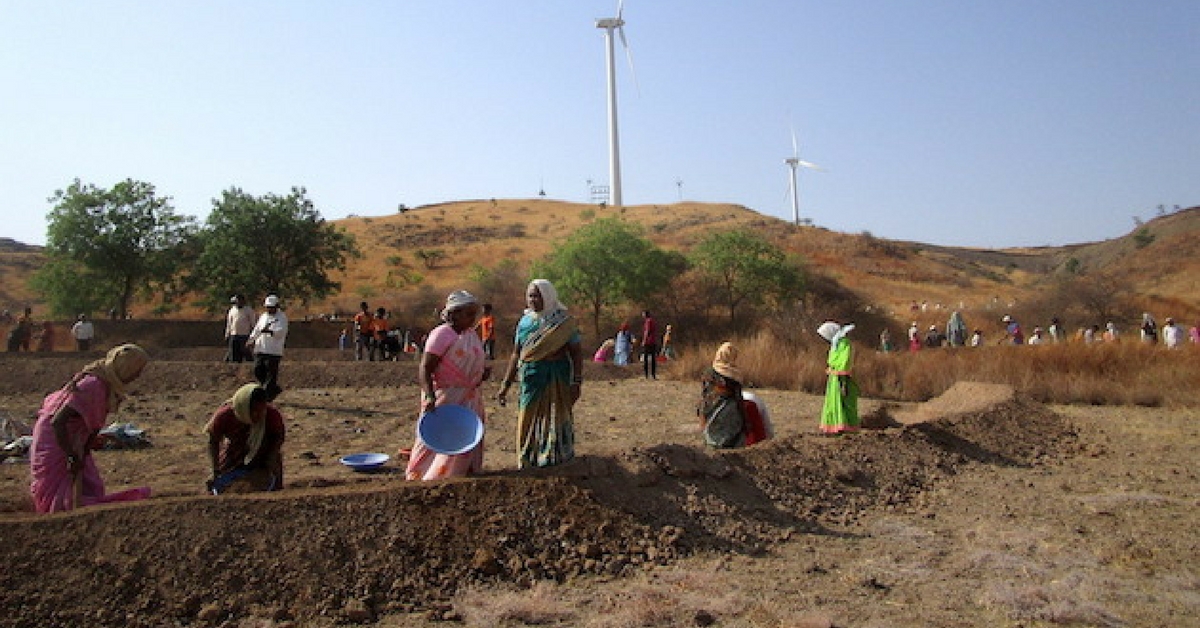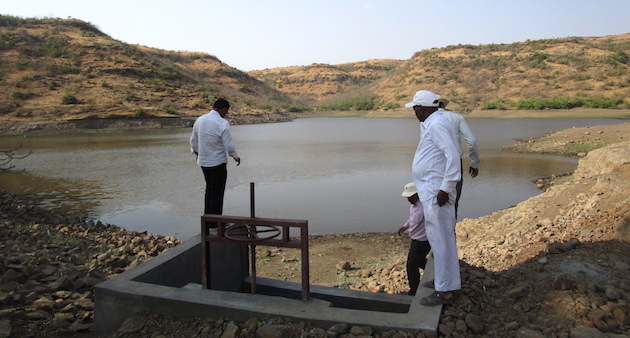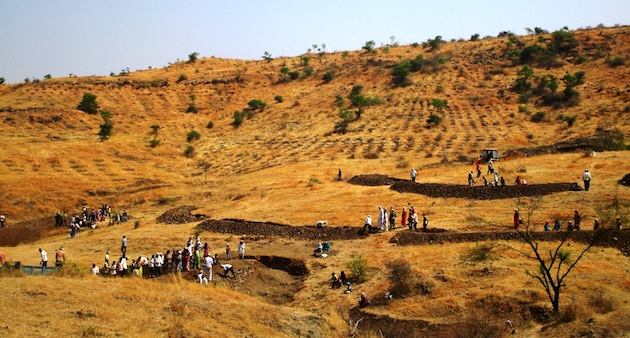TBI Blogs: Over 1,300 Villages in Maharashtra Are Using Water-Harvesting to Overcome Drought
As part of the Satyameva Jayate Water Cup 2017, over 1,300 villages in drought-prone areas of Maharashtra are creating water-harvesting structures to overcome chronic water scarcity, particularly during the hot season. Nidhi Jamwal takes a closer look.

Exactly a year ago, armed with iron rods and spades, a group of residents of Nigadi village in Koregaon taluka (administrative block) of Satara walked upstream to the neighboring Kanerkhed village. One after another, they broke down all the 30 bandhara (earthen check dams) that villagers of Kanerkhed had constructed on a local stream to harvest rainwater. The seasonal rivulet, originating from the nearby hills, used to flow down from Kanerkhed village to Nigadi, meeting the latter’s drinking water and irrigation needs.
“Last summer, we faced acute water scarcity. Forget irrigation, we had limited water for drinking purposes,” reminisced Santosh Krishan Jagtap, a resident of Nigadi village. “When we heard that Kanerkhed residents had constructed 30 bandhara on the local stream, we feared no water would flow down to our village. Hence, we broke all the bandhara,” he told VillageSquare.in.
Change of heart
However, a year later, there is a complete change of heart of over 1,100 residents of Nigadi, who are now busy constructing bandhara and other water harvesting structures to drought-proof their village. The credit for this volte-face goes to Jaigaon, another village further upstream of Kanerkhed.
Till last summer, Jaigaon, like Nigadi, was gripped with water scarcity. But rather than waiting for the situation to get worse, its residents adopted watershed management works. “Till 2015, Jaigaon was a well-known tanker village. We used to regularly hear stories of fights over water among its residents,” said Sachin, another resident of Nigadi. “But last April and May, villagers did shramdan to carry out watershed works. This year, even in peak summer months, Jaigaon has 24×7 water available in all its wells. We are amazed at its transformation.”
The 260 families of Nigadi are confident that if Jaigaon could drought-proof itself through watershed management, so can they. Since early April this year, Nigadi residents are daily doing shramdan (voluntary labour) to create rainwater-harvesting structures to end their water woes. By the end of April, its residents had already completed 2,200 cubic meters (m3) of continuous contour trenches (CCT), and planned to finish 7,200 m3 before the arrival of the southwest monsoon. CCTs help in breaking down the speed of flowing water and recharging groundwater.
Recharging groundwater
Compartment embankments ensure water from farmland does not wash away, but recharges groundwater. “We have completed 10 hectares of compartment bunding and will finish another 40 hectares by May-end. Apart from constructing a series of loose boulder structures on the local streams, we have also planned 2 km. of road water harvesting,” Sachin told VillageSquare.in. Loose boulder structures slow down the speed of water flowing down the hills and also control soil erosion.
Nigadi residents are also constructing a unique bandhara using discarded one-liter plastic bottles. Put together, all these water-harvesting structures will recharge the groundwater, which the villagers claim will raise water table in the dug wells and hand pumps. “Next summer, like Jaigaon, we too will be a paanidaar (water-sufficient) village,” said Narayan Shankar Jagtap, a 75-year-old retired army soldier and resident of Nigadi.

Training local water managers
Nigadi isn’t the only village in Maharashtra trying to drought-proof itself. Over 1,300 villages in 30 talukas of Maharashtra are at present creating water-harvesting structures to drought-proof themselves. These villages are participating in a unique competition on watershed management instituted by the non-profit Paani Foundation.
Titled Satyamev Jayate Water Cup 2017, as part of the competition, three non-profits – Paani Foundation, Watershed Organisation Trust (WOTR), and Sparsh-Centre for Participatory Learning – have trained over 5,000 villagers across drought-prone talukas of Maharashtra on watershed works.
Between April and May this year, the residents of 1,300 participating villages are creating various water harvesting structures in keeping with the ridge-to-valley approach. A technical team will assess these structures, and the three best villages will be awarded on August 15.
“Each village’s gram sabha (village council) nominated five villagers, including two women, who were given four-day field-based training on watershed management,” Balasaheb Shinde, a farmer from Jakan village and zonal coordinator of Paani Foundation in Satara, told VillageSquare.in.
Ridge to valley
Apart from learning to read contour maps, villagers have been trained to construct various water harvesting structures, such as earthen dams, loose boulder structures, CCT and deep CCT, compartment bunding, etc. The principle of ridge-to-valley is the basis of these trainings held in February and March this year.
“As part of watershed management, works should begin from the ridge and then come downwards. This ensures no soil erosion and benefits the entire village,” said Rajendra Pawar, village chief of Pawarwadi village in Koregaon taluka, who attended one such training program.
Several village women have been trained too. “After this training, we are confident that we can drought-proof villages receiving as little as 300-400 mm. annual rainfall,” Shubhangi Mahendra Phatare of Kumte village in Khatau taluk, which is participating in the Water Cup 2017, told VillageSquare.in.
Community involvement
Unlike government programmes, training villagers is the most important element of the Water Cup, as local villagers have to be involved actively in drought-proofing their villages. “Villagers create and maintain the structures and thus have a strong sense of ownership,” said Abha Laad, an organic farmer from Koregaon taluk. He is also a coordinator with Paani Foundation.
Trained villagers have further trained more people in their respective villages. For instance, five trained villagers of Kiraksal village in drought-prone Maan taluk have trained 88 more residents of Kiraksal. “This way, the entire village feels like a part of the journey towards becoming paanidaar,” said Pankaj Katkar, resident of Kiraksal.
The gram sabhas of all 1,300 villages participating in the competition have passed resolutions to adopt watershed management. Daily shramdan is accomplishing the majority of the works. “Only for deep CCT and cement bunds, we are using machinery. Rest is villagers’ voluntary labour,” says Uddhav Katkar of Kiraksal. According to him, the residents of Kiraksal have already done shramdan worth ₹25-30 lakh.
People’s movement on water
Over 190 families of Pawarwadi in Koregaon taluk are working day and night to complete the watershed works they have planned as part of the Water Cup 2017. These include 1,200 plantation pits, 40 hectares (ha) of CCT, 76 ha of deep CCT, 100 ha of compartment bunding, five farm ponds, 25 earthen dams, 200 loose boulder structures, 10 gabian structures, three cement-nullah-bunds, 190 magic pits, and 7,000 metres of nullah deepening.
According to Rajendra Pawar, sarpanch of Pawarwadi, enlisting the entire village’s participation was crucial to undertake watershed works. “Hence, before starting the works, we used to have a daily prabhat pheri informing villagers about watershed works planned for the village. Once convinced of the benefits, villagers came forward for shramdan in hundreds,” Rajendra told VillageSquare.in.
“As part of the CCT works, I am digging trenches on the hill slope. These trenches will hold rainwater flowing down the hills and recharge groundwater,” explained Tai Pandurang Kadam, a resident of Pawarwadi.

Voluntary participation
While the majority of the Pawarwadi villagers (at least 450 at one time) are doing shramdan in the mornings, a group of young men have formed a team that works in the night with the help of torches and lanterns.
Pawarwadi residents have also opened a separate bank account for watershed works. “We have collected voluntary contribution worth ₹7 lakh from people living in the village or outside. We haven’t sought any funds from the government,” said Maan Singh, resident of Pawarwadi.
A couple of kilometers away from Pawarwadi, Navibudruk village is also participating in the Water Cup 2017. The villagers have formed 21 groups and distributed watershed works among themselves with daily targets. “On April 20, we had our annual village mela which had various programmes, orchestra, etc. We willingly cancelled it and used its money for water works,” informed Rahul Nikam, sarpanch of Navibudruk.
Special incentive
Prakash Nikam, another resident of Navibudruk, has come up with a special prize offer to ensure maximum shramdan. “At the end of May, we will do a lucky draw of villagers who complete all 45 days of daily shramdan. I will give a refrigerator to the lucky winner,” informed Prakash. There is also a second and third prize of a fan and a mixer respectively, by the village’s self-help group.
This is the second year of Paani Foundation’s Water Cup initiative. Last year, 116 villages in three talukas of Maharashtra participated in Water Cup 2016. Velu village in Koregaon taluk received the first prize. “Through watershed works, we saved 281.69 crore liters of water and have become a tanker-free village. We are doing more watershed works to ensure we have sufficient water for both drinking water and irrigation,” Navnath Bhosle, resident of Velu, told VillageSquare.in.
As per Paani Foundation’s estimate, the villages participating in the last Water Cup created a water storage capacity of 1,368 crore litres, that is equivalent to 13,68,000 tankers of water, or ₹272 crore worth of water savings.
This year, over 1,300 villages in 30 drought-prone talukas of 13 districts are participating in the Water Cup 2017. Paani Foundation expects immense water savings. “The Water Cup is only a means to connect the rural people to their traditional wisdom of water harvesting. By training them, we hope to empower them so that they bring their own water,” said Laad.
Adapted from an article originally published on VillageSquare.in. Subscribe to VillageSquare’s weekly update on the website for more stories from rural India.
Like this story? Or have something to share? Write to us: [email protected], or connect with us on Facebook and Twitter.
NEW: Click here to get positive news on WhatsApp!
If you found our stories insightful, informative, or even just enjoyable, we invite you to consider making a voluntary payment to support the work we do at The Better India. Your contribution helps us continue producing quality content that educates, inspires, and drives positive change.
Choose one of the payment options below for your contribution-
By paying for the stories you value, you directly contribute to sustaining our efforts focused on making a difference in the world. Together, let's ensure that impactful stories continue to be told and shared, enriching lives and communities alike.
Thank you for your support. Here are some frequently asked questions you might find helpful to know why you are contributing?


This story made me
-
97
-
121
-
89
-
167














